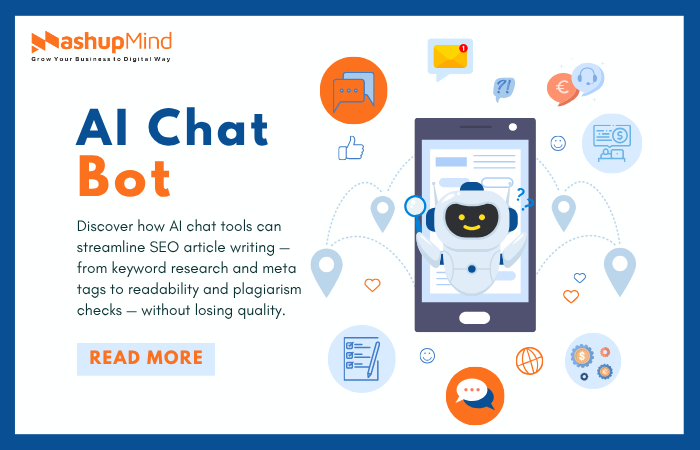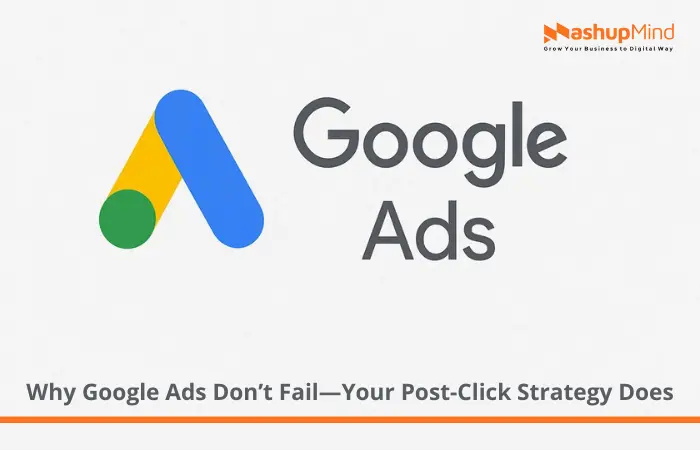Search engines do not want content. They want optimized, high-quality, user-friendly content.
That’s why 90.88% of all the webpages get no traffic from Google searches. It means if your content is not SEO-friendly, it is practically impossible.
Some people even joke that Google’s second result page is the best place to hide a dead body.
The thing is, writing SEO-optimized articles takes time. It involves finding the right keywords, writing meta titles, using compelling intros, and making sure it all sounds natural.
That’s where marketers start using AI tools. They’re fast and available 24/7. Plus, they know the best practices of SEO. But how much can AI help in SEO?
So, in this article, I will tell you how AI chat helps me create SEO-friendly content through each step of SEO writing.
How AI chat helps write SEO-friendly articles?
Instead of just listing what AI can theoretically do, I will show you the results. The same way I write an SEO article for a client or my blog.
From keyword research to crafting the meta description, I will ask an AI chatbot to do it all.
1. Keyword research with AI chat
The first thing about writing an article is keyword research. Because if you’re not targeting the right keywords, even the best article won’t get traffic.
So, I ask my AI chat:
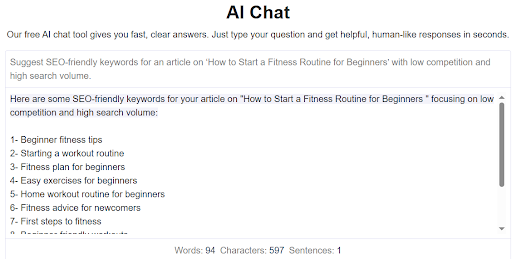
And it gives me a pretty solid list. Things like beginner workout plans, easy exercises for beginners, and first steps to fitness.
But it does not provide search volumes or keyword difficulty. For that, I cross-check with keyword tools. Such as Ubersuggest and SEMrush.
After checking them, I make a list of actual keywords. Only the words and phrases that actually have some search volume.
This means AI chat is good for brainstorming keyword ideas and variations quickly. But you still need actual SEO tools to verify numbers and competitiveness. It cuts down time, but not the research step entirely.
2. Structuring articles with SEO in mind
Once I finalize my keywords, the ones with real search volume and manageable competition. I hand them over to the AI chat.
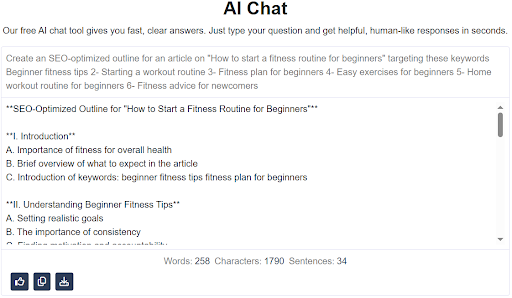
Within seconds, the tool gives me a clean outline. It includes an introduction, H2s with my keywords, a few supporting H3s, a conclusion, and even a suggested FAQ section. All logically ordered.
What impresses me the most is that it naturally includes keyword variations in the subheadings. For example, instead of repeating one keyword in every heading, it switched them with different keywords from my list.
That’s exactly what you want for good on-page SEO headings.
3. Generating meta titles and descriptions
After having a logical structure, I use the AI chatbot to write strong meta titles and descriptions. It’s important as it’s the first thing people see in search results.
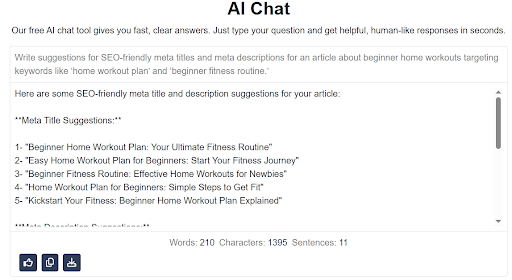
The AI instantly gives multiple options. And some of them are solid, clear, within character limits, and include primary and secondary keywords without sounding robotic.
So, I think AI chat can absolutely generate solid meta titles and descriptions. I still have to tweak some words to match my content’s voice better. But it saves me at least 10–15 minutes.
4. Keyword placement and semantic optimization
By now, I have the structure, title, and description. So I move on to keyword placement in SEO writing, naturally.
For that, I always ask it to write a paragraph on one of the headings it gives me and ask the free AI chat tool to use some keywords in it naturally.
The AI doesn’t just use keywords in random spots. It actually writes the content with a flow that feels human. No keyword is used out of context.
So, AI chat does a decent job with keyword placement. This kind of optimization isn’t just good for SEO. It helps my article sound richer and more complete.
5. Creating Alt texts and captions
Images are a key part of SEO. Their alt texts are another source of putting keywords in the article.
So I always ask the free AI chat by paragraph-generator.com for image alt texts.
It cannot read images, so I describe each image in words to get alt texts for them.
The results are not bad. It is a descriptive phrase with keyword relevance and within the ideal length for alt tags.
I ask for captions as well.
It successfully aligns the caption with my content’s message and tone. That improves engagement and helps me boost my online presence.
I still modify them for branding and my personal tone, but it definitely saves me time and keeps everything aligned.
6. Using relevant entities and context
SEO isn’t just about keywords anymore. Google now looks for context, which is developed through keywords and entities. These are key terms and related phrases that show the depth of a topic.
For example, you’re writing on electric cars. Words like “battery range,” “Tesla,” “charging stations,” and “EV tax credit” are expected. These build context and show that you know the topic.
So, I ask the chatbot to get relevant terms for my topic.
The results are pretty good. This means it knows the topic. Then I create content that mentions all of these entities. The resulting article is good for SEO and valuable for my readers.
7. Internal linking suggestions
Internal links are important for on-page SEO. They guide users to other helpful pages on my website. Plus, show search engines how my content connects.
But finding the right anchor texts for links is time-consuming. Especially when a site has dozens of pages.
That’s why I ask this ChatGPT-based AI chat about that too.
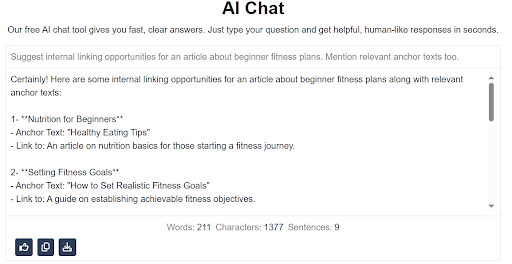
It never disappoints me. It suggests relevant pages to link which give more context to my current article.
Then I give a sample blog from my website. It scans the content to suggest anchor texts for links. It recommends where they would make the most sense for a reader.
It’s a great AI assistant for keeping my site structure strong. All without making my content feel overloaded with links.
8. Maintaining readability and tone
SEO is not only for Google, it is for our readers as well. So the content should be easy to understand.
But if your article is hard to read or feels robotic, readers will bounce. And Google will think it is not worth reading.
So I read my article after I am done writing. And look for any hard-to-read line. I rewrote them in easy language with the help of this chatbot.
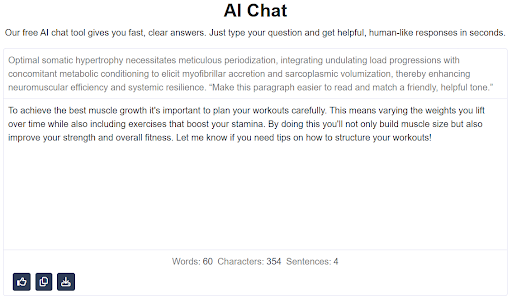
It simplifies long sentences and removes jargon. Even replaces passive voice with active voice.
More importantly, it maintains the tone I ask for.
9. Creating summaries for long articles
When my article is too long, I add a summary with it. Because many people will read only that. So, at least my message is delivered.
For that, I used to summarize text with summary-generator.net before. It was so easy to use and has different modes for summaries. I was able to generate my summaries in paragraphs, bullet points, and headlines.
But now, I am using only AI chat for everything. I ask it to summarize my article. It makes this step even simpler than the summary generator.
10. Avoiding plagiarism and AI detection
Search engines are smarter than ever. They do not just rank by keywords, but also by originality and authenticity. That’s why I never skip this step.
After generating content, I always check for plagiarism. Most paragraphs pass clean. But the plagiarism checker of paraphrasingtool.us highlights some of the sentences. So, light editing is still necessary. Which I do with this AI chat. I provide it with my flagged sentences and ask it to rewrite them.
Then comes the AI detection part. Some clients and Google want completely human-written content. So, I always use AI detectors like detektify.
If any part is highlighted by detektify.com, I ask the AI chat to humanize it.
Yes, I have to add my human touch later. But that takes much less time than doing it from scratch.
Conclusion
AI chat tools will not replace SEO writers. They improve our efficiency and reduce our repetitive work.
When used smartly, they help us in research, writing, SEO, and content editing. The difference is in how you guide them.
So, start using AI chat today and become more efficient in writing your SEO-friendly articles.

